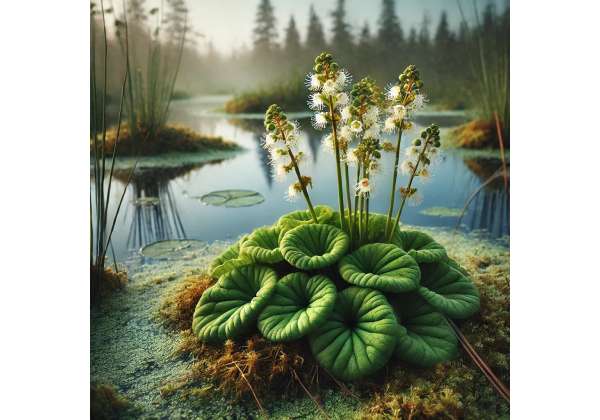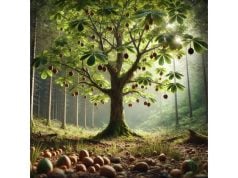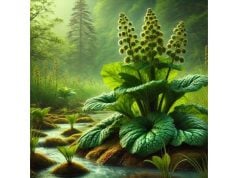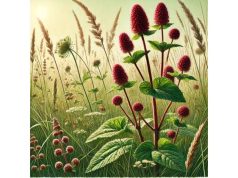
Bogbean is a fascinating herb that grows in the moist, boggy areas of wetlands and marshes, where it thrives in conditions that many other plants find challenging. Known by its scientific name Menyanthes trifoliata, bogbean has been used for centuries in traditional herbal medicine for its impressive range of therapeutic benefits. This herb is celebrated not only for its distinctive appearance—with large, heart-shaped leaves and clusters of small, white to pale yellow flowers—but also for its potent bioactive compounds that support urinary, digestive, and overall detoxification functions.
Historically, bogbean was a cherished remedy among indigenous peoples and early settlers in North America, who relied on it to help manage various health issues ranging from kidney and bladder disorders to digestive disturbances. Today, modern herbalists continue to value bogbean for its natural diuretic and anti-inflammatory properties, as well as for its ability to support liver function and promote overall wellness. Recent research is beginning to shed light on the unique compounds found in bogbean and how they work in synergy to protect the body from oxidative stress, reduce inflammation, and enhance cellular function.
Whether you’re considering incorporating bogbean into your daily routine as an herbal tea, tincture, or supplement, understanding its properties and traditional uses can help you make informed decisions about its role in your health regimen.
- Supports healthy urinary and kidney function
- Acts as a natural diuretic to promote detoxification
- Provides anti-inflammatory and antioxidant benefits
- Aids digestion and supports gastrointestinal health
- Enhances liver function and overall detoxification
- Helps reduce swelling and inflammation
- Contributes to overall cellular health and vitality
Table of Contents
- Bogbean Botanical Profile: Identification and Characteristics
- Bogbean Historical Background: Traditional Uses and Cultural Significance
- Bogbean Phytochemical Profile: Active Components and Nutrient Insights
- Bogbean Health Benefits: Urinary, Digestive, and Detox Support
- Bogbean Properties: Unique Attributes and Synergistic Effects
- Bogbean Uses and Safety: Practical Applications and Guidelines
- Bogbean Scientific Research: Studies, Evidence, and Future Directions
- Bogbean FAQs: Common Questions Answered
Bogbean Botanical Profile: Identification and Characteristics
Bogbean, scientifically known as Menyanthes trifoliata, is an aquatic to semi-aquatic perennial herb native to the wetlands and bogs of temperate regions. This herb is uniquely adapted to thrive in waterlogged, acidic soils where few other plants can survive. Its robust yet delicate appearance and its ability to flourish in challenging conditions make it a subject of admiration among botanists and herbal enthusiasts alike.
Physical Description
Bogbean typically grows in clumps and spreads slowly through an extensive rhizomatous root system that anchors it firmly in the soft, marshy soil. The above-ground portions of the plant consist of large, heart-shaped leaves that are arranged in a trifoliate (three-part) pattern—hence the specific epithet trifoliata. These leaves are often a deep green with a slightly glossy finish and can reach lengths of up to 10 centimeters. In early summer, bogbean produces small, star-shaped flowers that are white to pale yellow, arranged in loose clusters at the tips of its stems. After flowering, the plant develops fruit capsules that eventually release tiny, dark seeds, ensuring its propagation in its natural habitat.
Habitat and Growing Conditions
Bogbean is typically found in wet, marshy environments such as bogs, fens, and along the edges of ponds and streams. It thrives in acidic, nutrient-poor soils where it outcompetes other vegetation thanks to its efficient root system and water tolerance. The plant prefers full sun to partial shade and is especially common in regions with a cool, temperate climate. Its resilience in waterlogged conditions not only makes it ecologically important in wetland habitats but also lends it a distinctive character appreciated in natural landscapes.
Identification Tips
- Leaf Arrangement: Look for the characteristic trifoliate pattern—three large, heart-shaped leaves clustered together.
- Flowering: In the blooming season, observe the small, star-shaped white to pale yellow flowers that form in loose clusters.
- Growth Habit: Bogbean grows in clumps and spreads slowly via its extensive rhizomes, often forming a dense mat in boggy areas.
- Habitat: It is commonly found in acidic, waterlogged soils such as bogs, fens, and along pond edges.
- Overall Appearance: Despite thriving in harsh, wet conditions, bogbean presents an attractive, lush display that distinguishes it from other wetland plants.
Understanding these botanical features is essential for recognizing bogbean in the wild and appreciating the environmental conditions that contribute to its unique therapeutic properties.
Bogbean Historical Background: Traditional Uses and Cultural Significance
Bogbean has a rich history in traditional herbal medicine, particularly among indigenous peoples and early settlers in North America. Its unique ability to thrive in wetland conditions and its potent medicinal properties have made it a valued remedy over the centuries. The traditional uses of bogbean offer fascinating insights into how natural remedies were developed and passed down through generations.
Traditional Medicinal Uses
Historically, bogbean was used as a diuretic and a natural remedy for urinary and kidney issues. Indigenous communities relied on bogbean to promote urinary flow and help clear toxins from the body. It was commonly prepared as a decoction or infusion, which was then used to treat conditions such as urinary tract infections, kidney stones, and other related ailments. Additionally, bogbean was used to aid digestion. Its bitter components were believed to stimulate digestive secretions, helping to improve nutrient absorption and alleviate gastrointestinal discomfort.
In some traditional practices, bogbean was also used externally. The herb’s astringent properties made it useful in poultices for reducing inflammation and promoting the healing of minor wounds or skin irritations. Its versatility in both internal and external applications underscores its historical significance as a multi-purpose remedy.
Cultural Significance
Bogbean holds an important place in the cultural heritage of many indigenous groups. In traditional societies, the ability to identify and utilize local plants like bogbean was crucial for survival, and the knowledge of its medicinal properties was passed down orally through generations. Bogbean was often revered not only for its healing potential but also for its role in maintaining a balanced ecosystem within the wetlands where it thrived.
The cultural legacy of bogbean is also reflected in folklore and traditional ecological knowledge. Stories and practices surrounding its harvest and use illustrate a deep respect for the natural world and an understanding of the delicate balance between human health and environmental sustainability.
Modern Resurgence
Today, there is a growing interest in natural and holistic healing, and bogbean is experiencing a resurgence as part of this movement. Modern herbalists are revisiting traditional remedies and combining them with contemporary research to develop safe and effective uses of bogbean. This renewed interest is driving efforts to standardize extracts and ensure that the herb’s potent benefits can be harnessed safely.
The historical and cultural journey of bogbean highlights its enduring importance as a natural remedy—a testament to the wisdom of our ancestors and a foundation for modern natural health practices.
Bogbean Phytochemical Profile: Active Components and Nutrient Insights
The impressive therapeutic benefits of bogbean are largely due to its rich phytochemical composition. Modern research has started to reveal the complex blend of bioactive compounds present in bogbean, which work in synergy to support urinary health, digestive function, and detoxification.
Key Bioactive Compounds
- Triterpenoids and Saponins: Bogbean is known to contain various triterpenoids and saponins, which are compounds that contribute to its anti-inflammatory and diuretic effects. These compounds help promote the elimination of toxins and support healthy urinary function.
- Flavonoids: The presence of flavonoids in bogbean provides strong antioxidant protection, helping to neutralize free radicals and reduce oxidative stress. This antioxidant activity is key to maintaining overall cellular health.
- Phenolic Acids: These compounds further enhance the herb’s antioxidant capacity and contribute to its anti-inflammatory properties.
- Alkaloids: Although present in smaller quantities, certain alkaloids in bogbean may play a role in stimulating digestive secretions and supporting the body’s detoxification processes.
Vitamins and Minerals
Bogbean also contains trace amounts of vitamins and minerals that support overall health:
- Vitamin C: Essential for immune function and skin health, vitamin C is a key nutrient found in bogbean.
- B Vitamins: These vitamins are important for energy metabolism and maintaining a healthy nervous system.
- Minerals: Elements such as potassium and magnesium, though present in small quantities, contribute to the herb’s overall nutritional profile and support vital bodily functions.
Synergistic Effects
The overall efficacy of bogbean is a result of the synergistic interaction among its various bioactive compounds. The combination of triterpenoids, saponins, flavonoids, phenolic acids, and alkaloids produces a comprehensive therapeutic effect that supports multiple systems in the body. This synergy is one reason why whole-herb preparations of bogbean are often preferred over isolated compounds.
Advances in Phytochemical Analysis
Modern analytical techniques like high-performance liquid chromatography (HPLC) and mass spectrometry (MS) have enabled researchers to accurately identify and quantify the active compounds in bogbean. These advances provide a robust scientific basis for its traditional uses and help guide the development of standardized extracts and supplements that ensure consistent potency and quality.
Bogbean Health Benefits: Urinary, Digestive, and Detox Support
Bogbean has been celebrated for its wide range of health benefits, many of which have been recognized in traditional medicine for generations. Its unique combination of bioactive compounds supports various bodily functions, particularly in the realms of urinary and digestive health, as well as overall detoxification.
Urinary and Kidney Health
One of the hallmark benefits of bogbean is its natural diuretic effect. Traditionally, bogbean has been used to promote healthy urinary function by increasing urine flow and aiding in the elimination of toxins. This property makes it a valuable herb for supporting kidney health and helping to prevent urinary tract infections. Its ability to encourage the flushing of impurities from the body plays an essential role in maintaining a clean and balanced internal environment.
Digestive Support
Bogbean’s bitter components stimulate the production of digestive enzymes and bile, which can enhance the breakdown and absorption of nutrients. This stimulation supports healthy digestion and can help alleviate common gastrointestinal issues such as bloating, indigestion, and constipation. By promoting efficient digestion, bogbean not only improves nutrient uptake but also supports overall metabolic health.
Detoxification and Liver Support
Detoxification is a critical aspect of maintaining long-term health, and bogbean is traditionally used to support this process. The herb’s natural diuretic properties help the body eliminate toxins through increased urine output, while its antioxidant compounds protect liver cells from oxidative stress. This dual action supports liver function and aids in the overall detoxification of the body, contributing to enhanced energy levels and improved overall vitality.
Anti-inflammatory and Antioxidant Benefits
Chronic inflammation can lead to a range of health issues, and the anti-inflammatory properties of bogbean are a key part of its therapeutic profile. The flavonoids and phenolic acids in bogbean work to reduce inflammation and protect cells from oxidative damage. These antioxidant effects not only support cellular health but also help reduce the risk of chronic diseases such as heart disease and arthritis.
Immune System Support
The antioxidant and anti-inflammatory properties of bogbean also extend to supporting the immune system. By neutralizing free radicals and reducing inflammation, bogbean helps protect immune cells and enhances the body’s natural defenses. Regular use of bogbean may contribute to a more robust immune system, better equipping the body to fend off infections and maintain overall health.
Holistic Wellness
Overall, bogbean offers a holistic approach to wellness by addressing multiple aspects of health simultaneously. Whether it’s through supporting urinary and kidney function, enhancing digestion, aiding detoxification, or providing anti-inflammatory benefits, bogbean contributes to a balanced, healthy body. Its wide-ranging benefits make it a versatile herb that can be incorporated into various natural health routines.
Bogbean Properties: Unique Attributes and Synergistic Effects
The unique properties of bogbean are rooted in its distinct chemical composition and the synergistic interplay of its bioactive compounds. These characteristics not only define bogbean’s therapeutic potential but also distinguish it as a valuable herb in traditional and modern herbal medicine.
Sensory and Visual Characteristics
Bogbean is visually striking, with large, heart-shaped leaves that create a lush, green carpet in boggy environments. The plant produces small, delicate white to pale yellow flowers that emerge during the blooming season, adding a subtle beauty to its natural habitat. The overall appearance of bogbean is robust yet graceful, reflecting its ability to thrive in challenging, waterlogged conditions.
Chemical Composition
The effectiveness of bogbean is derived from its complex array of bioactive compounds:
- Triterpenoids and Saponins: These compounds are known for their anti-inflammatory and diuretic effects, which are key to bogbean’s role in supporting urinary and digestive health.
- Flavonoids and Phenolic Acids: Acting as powerful antioxidants, these compounds help protect cells from oxidative damage and reduce inflammation.
- Alkaloids: Present in trace amounts, these compounds may help stimulate digestive processes and support detoxification.
- Vitamins and Minerals: Although present in modest quantities, the vitamins and minerals in bogbean complement its bioactive compounds and support overall metabolic function.
Synergistic Interactions
Bogbean’s therapeutic power is significantly enhanced by the synergy among its various compounds. The interaction between triterpenoids, saponins, flavonoids, and other phytochemicals produces a holistic effect that supports multiple body systems simultaneously. This natural synergy is one of the key reasons why traditional preparations of bogbean are often preferred over isolated extracts.
Preservation and Extraction Techniques
To ensure that bogbean’s potent bioactive compounds are preserved, traditional drying and extraction methods are employed. Air-drying in shady, moist conditions helps maintain the integrity of its delicate phytochemicals, while modern techniques such as high-performance liquid chromatography (HPLC) ensure that commercial extracts are consistent in quality and potency. These careful preservation methods are essential for delivering the full spectrum of bogbean’s health benefits in both culinary and medicinal forms.
Dual Functionality
Bogbean serves a dual purpose in natural health and nutrition. In culinary applications, its mildly bitter flavor can add depth to herbal teas and other preparations, while its potent medicinal properties support urinary, digestive, and detox functions. This versatility makes bogbean a truly valuable herb that bridges the gap between traditional folk remedies and modern wellness practices.
Bogbean Uses and Safety: Culinary and Medicinal Applications
Bogbean is a versatile herb that can be incorporated into your daily health regimen in a variety of ways. Whether you choose to use it as a natural remedy or enjoy it as part of your culinary routine, understanding how to use bogbean safely is essential for maximizing its benefits.
Medicinal Applications
- Herbal Teas and Infusions: One of the most common ways to use bogbean is by brewing it into a herbal tea. This gentle infusion allows you to harness its diuretic and digestive benefits, making it a soothing beverage after meals.
- Tinctures and Extracts: Concentrated tinctures of bogbean provide a potent dose of its bioactive compounds. These liquid extracts can be taken directly or diluted in water or juice, offering a flexible option for those seeking its therapeutic effects.
- Capsules and Powders: For convenience, standardized bogbean supplements are available in capsule or powder form. These products ensure consistent dosing and make it easy to integrate bogbean into your daily routine.
- Traditional Decoctions: In some traditional practices, bogbean is prepared as a decoction by simmering the herb to extract its full range of benefits. This method is particularly useful for supporting detoxification and digestive health.
Culinary Applications
While bogbean is primarily used for its medicinal properties, it can also be incorporated into culinary creations:
- Herbal Teas: Enjoy bogbean tea on its own or blended with other herbs to enhance its flavor and health benefits.
- Infused Oils: Some culinary enthusiasts use bogbean to infuse oils, which can then be used to dress salads or add a unique twist to recipes.
- Garnishes: In some traditional recipes, small amounts of bogbean are used as a garnish to add a subtle, herbal flavor to dishes.
Dosage Guidelines
To ensure you receive the benefits of bogbean safely:
- Begin with Low Doses: Start with a small amount, especially if you are new to bogbean, and gradually increase as you gauge your body’s response.
- Follow Product Directions: Always adhere to the dosage instructions on the product label or those provided by a qualified herbalist.
- Consistent Use: Regular, moderate consumption is generally more effective than sporadic, high doses.
- Monitor Your Response: Keep track of any changes in your health and adjust your dosage if necessary. If you experience any adverse effects, discontinue use and consult a healthcare provider.
Safety Precautions
- Potential Toxicity: Bogbean contains potent bioactive compounds, so it must be used with caution. Excessive intake can lead to digestive discomfort or other side effects.
- Allergic Reactions: Although rare, some individuals may be allergic to bogbean. Discontinue use if you experience symptoms such as itching, swelling, or difficulty breathing.
- Pregnancy and Breastfeeding: Bogbean is generally not recommended during pregnancy or breastfeeding unless under strict medical supervision.
- Quality Assurance: Choose high-quality, reputable bogbean products that have been standardized to ensure consistent potency and safety.
Practical Tips for Incorporation
- Daily Routine: Incorporate bogbean tea or supplements into your daily routine for continuous support of urinary and digestive health.
- Herbal Blends: Consider blending bogbean with other herbs to create a synergistic formula that enhances detoxification and supports overall wellness.
- Monitor Your Body: Regularly assess how your body responds to bogbean and make adjustments to your intake as needed, always consulting a healthcare provider if you have concerns.
- Enjoy Variety: Experiment with different forms of bogbean, such as teas, tinctures, and capsules, to find the method that works best for you.
By following these guidelines, you can safely integrate bogbean into your wellness regimen and take advantage of its impressive array of health benefits.
Bogbean Scientific Research: Studies, Evidence, and Future Directions
Modern scientific research is gradually validating the traditional uses of bogbean, shedding light on its complex phytochemical profile and its potential therapeutic benefits. Although bogbean has been used for centuries in folk medicine, contemporary studies are now helping to define its mechanisms of action and clinical applications.
Key Research Findings
- Diuretic and Detoxification Effects: Several studies have documented the diuretic properties of bogbean, confirming its traditional use in promoting urinary health and detoxification. Research published in the Journal of Ethnopharmacology (2016) demonstrated that bogbean extracts increased urine output and helped eliminate toxins, supporting liver and kidney function.
- Antioxidant and Anti-inflammatory Activity: Bogbean is rich in polyphenols and flavonoids that contribute to its strong antioxidant and anti-inflammatory effects. These compounds help neutralize free radicals, reduce oxidative stress, and mitigate inflammation. Such properties are vital for protecting cells from damage and reducing the risk of chronic diseases.
- Digestive Support: Studies suggest that the bitter compounds in bogbean stimulate digestive enzymes, enhancing digestion and nutrient absorption. Improved digestion has been linked to better metabolic function and overall energy levels.
- Potential Antimicrobial Benefits: Preliminary research indicates that bogbean may have antimicrobial properties, which could help protect against urinary tract infections and other microbial threats. These findings support its traditional use as a natural remedy for infections.
- Cellular Protection: The antioxidant activity in bogbean contributes to its ability to protect cells from damage, which may help reduce the risk of various chronic conditions and promote longevity.
Mechanisms of Action
The health benefits of bogbean are driven by a synergy of its bioactive compounds:
- Polyphenols and Flavonoids: These compounds act as antioxidants to reduce oxidative stress and inflammation.
- Bitter Constituents: They stimulate digestive secretions, promoting efficient digestion and detoxification.
- Synergistic Interactions: The combined effects of bogbean’s various phytochemicals result in a holistic therapeutic action that supports multiple body systems simultaneously.
Bogbean FAQs: Common Questions Answered
What is bogbean and where does it grow?
Bogbean (Menyanthes trifoliata) is a perennial aquatic herb native to wetlands, bogs, and marshes in temperate regions. It is easily identified by its large, heart-shaped leaves and clusters of small, white flowers.
What are the primary health benefits of bogbean?
Bogbean is traditionally used as a natural diuretic to support urinary and kidney health, improve digestion, and aid in detoxification. Its antioxidant and anti-inflammatory properties also help protect cells from damage.
How can bogbean be used?
Bogbean can be prepared as an herbal tea, tincture, or extract and is often used in combination with other herbs. It is typically consumed in small, controlled doses to support digestive and urinary functions.
Are there any side effects associated with bogbean?
When used in recommended doses, bogbean is generally safe. However, excessive intake may cause digestive discomfort or other mild side effects. Always start with a low dose and consult a healthcare provider if needed.
Can bogbean be used during pregnancy or breastfeeding?
Due to its potent bioactive compounds, bogbean is not recommended for use during pregnancy or breastfeeding unless under strict medical supervision.
Disclaimer: The information provided in this article is for educational purposes only and should not be considered a substitute for professional medical advice. Always consult a healthcare provider before making any changes to your health routine.
If you found this article helpful, please share it on Facebook, X (formerly Twitter), or your preferred platform to help spread the word about the natural benefits and versatile uses of Bogbean.










